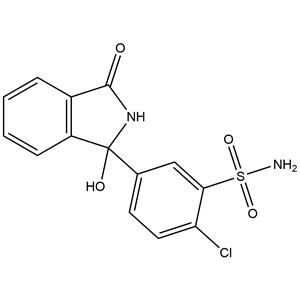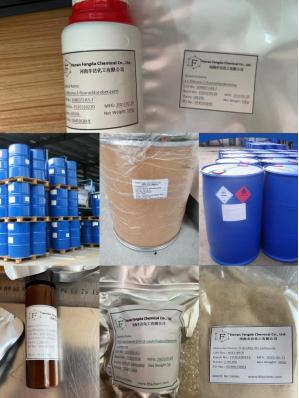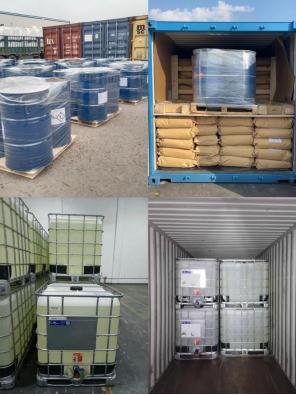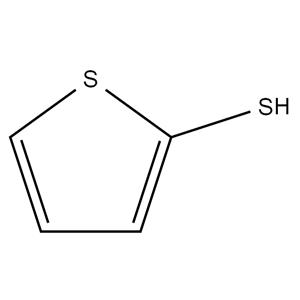
Chlortalidone NEW
| Price | $35 | $1.2 |
| Package | 1kg | 1000kg |
| Min. Order: | 1kg |
| Supply Ability: | g-kg-tons, free sample is available |
| Update Time: | 2024-04-18 |
Product Details
| Product Name: Chlortalidone | CAS No.: 77-36-1 |
| Min. Order: 1kg | Purity: 99% |
| Supply Ability: g-kg-tons, free sample is available | Release date: 2024/04/18 |
| Lead time: In stock, ready for shipment | Packaging: bag/bottle/drum/IBC |
| Delivery: By express, by air, by sea | Origin: Manufacturer, advantage product |
| COA, MSDS: Available, contact us for details | Name: Mia |
1. Materials information
| Name | chlorthalidone |
|---|---|
| Synonym | More Synonyms |
| Description | Chlorthalidone is a thiazide-like diuretic used to treat hypertension. |
|---|---|
| Related Catalog | Signaling Pathways >> Others >> Others Research Areas >> Cardiovascular Disease |
| In Vivo | Chlorthalidone is a thiazide-like diuretic. After oral intake, peak serum concentrations are achieved in 2-6 hours. The half-life of Chlorthalidone is approximately 42 (range 29-55) hours, reaching 45-60 hours after long-term dosing. However, interindividual variability in the half-life of Chlorthalidone is wide. Chlorthalidone is excreted unchanged by the kidneys. The natriuretic effect of Chlorthalidone is maximal at 18 hours and lasts more than 48 hours. Comparing different doses of Chlorthalidone, it has been observed that 25 mg daily is nearly as effective as higher doses, but with less risk of hypokalemia[1]. Chlorthalidone reduces calcium oxalate calculous recurrence but magnesium hydroxide does not. The effectiveness of Chlorthalidone or magnesium hydroxide is examined in the prevention of recurrent calcium oxalate kidney calculi. In a double-blind random allocation design daily dosages of 25 or 50 mg. Chlorthalidone, 650 or 1,300 mg. magnesium hydroxide, or an identical placebo are administered. All groups showed significantly decreased calculous events compared to the pretreatment rates. During the trial 56.1 per cent fewer calculi than predicted developed in the placebo group (p less than 0.01), whereas the groups receiving low and high dosage magnesium hydroxide showed 73.9 and 62.3 per cent fewer calculi, respectively (p less than 0.001 and less than 0.01, respectively). Chlorthalidone treatment results in a 90.1 per cent decrease from predicted rates and both dosages yielded similar results. When the treatments are compared Chlorthalidone is significantly better than the placebo or magnesium hydroxide (p less than 0.01). The large decreases in calculous events seen when placebo or ineffective therapy is given underscore the positive treatment bias that occurs when historical controls are used and they demonstrate the need for proper experimental design[2]. |
| References | [1]. Barrios V, et al. Which thiazide to choose as add-on therapy for hypertension? Integr Blood Press Control. 2014 Jul 30;7:35-47. [2]. Ettinger B, et al. Chlorthalidone reduces calcium oxalate calculous recurrence but magnesium hydroxide does not. J Urol. 1988 Apr;139(4):679-84. |
| Density | 1.6±0.1 g/cm3 |
|---|---|
| Melting Point | 265-267ºC (dec.) |
| Molecular Formula | C14H11ClN2O4S |
| Molecular Weight | 338.766 |
| Exact Mass | 338.012817 |
| PSA | 117.87000 |
| LogP | -0.74 |
| Index of Refraction | 1.694 |
| Storage condition | 2-8°C |
| Water Solubility | DMSO: soluble5mg/mL, clear (warmed) |
Section1. IDENTIFICATION OF THE SUBSTANCE/MIXTURE Product identifiers Product name: Chlorthalidone CAS-No.: 77-36-1 Relevant identified uses of the substance or mixture and uses advised against Identified uses: Laboratory chemicals, Manufacture of substances Section2. HAZARDS IDENTIFICATION Classification of the substance or mixture Classification according to Regulation (EC) No 1272/2008 [EU-GHS/CLP] Eye irritation (Category 2) This substance is not classified as dangerous according to Directive 67/548/EEC. Label elements Labelling according Regulation (EC) No 1272/2008 [CLP] Pictogram Signal wordWarning Hazard statement(s) H319Causes serious eye irritation. Precautionary statement(s) P305 + P351 + P338IF IN EYES: Rinse cautiously with water for several minutes. Remove contact lenses, if present and easy to do. Continue rinsing. Supplemental Hazardnone Statements Other hazards - none Section3. COMPOSITION/INFORMATION ON INGREDIENTS Substances Formula: C14H11ClN2O4S Molecular Weight: 338,77 g/mol Section4. FIRST AID MEASURES Description of first aid measures General advice Consult a physician. Show this safety data sheet to the doctor in attendance. If inhaled If breathed in, move person into fresh air. If not breathing, give artificial respiration. Consult a physician. In case of skin contact Wash off with soap and plenty of water. Consult a physician. In case of eye contact Rinse thoroughly with plenty of water for at least 15 minutes and consult a physician. If swallowed Never give anything by mouth to an unconscious person. Rinse mouth with water. Consult a physician. Most important symptoms and effects, both acute and delayed Gastrointestinal disturbance, Dermatitis, Nausea, Dizziness, Headache Indication of any immediate medical attention and special treatment needed no data available Section5. FIREFIGHTING MEASURES Extinguishing media Suitable extinguishing media Use water spray, alcohol-resistant foam, dry chemical or carbon dioxide. Special hazards arising from the substance or mixture Carbon oxides, nitrogen oxides (NOx), Sulphur oxides, Hydrogen chloride gas Advice for firefighters Wear self contained breathing apparatus for fire fighting if necessary. Further information no data available Section6. ACCIDENTAL RELEASE MEASURES Personal precautions, protective equipment and emergency procedures Use personal protective equipment. Avoid dust formation. Avoid breathing vapors, mist or gas. Ensure adequate ventilation. Avoid breathing dust. Environmental precautions Do not let product enter drains. Methods and materials for containment and cleaning up Pick up and arrange disposal without creating dust. Sweep up and shovel. Keep in suitable, closed containers for disposal. Reference to other sections For disposal see section 13. Section7. HANDLING AND STORAGE Precautions for safe handling Avoid contact with skin and eyes. Avoid formation of dust and aerosols. Provide appropriate exhaust ventilation at places where dust is formed. Conditions for safe storage, including any incompatibilities Store in cool place. Keep container tightly closed in a dry and well-ventilated place. Recommended storage temperature: 2 - 8 °C Specific end uses no data available Section8. EXPOSURE CONTROLS/PERSONAL PROTECTION Control parameters Components with workplace control parameters Exposure controls Appropriate engineering controls Handle in accordance with good industrial hygiene and safety practice. Wash hands before breaks and at the end of workday. Personal protective equipment Eye/face protection Safety glasses with side-shields conforming to EN166 Use equipment for eye protection tested and approved under appropriate government standards such as NIOSH (US) or EN 166(EU). Skin protection Handle with gloves. Gloves must be inspected prior to use. Use proper glove removal technique (without touching glove's outer surface) to avoid skin contact with this product. Dispose of contaminated gloves after use in accordance with applicable laws and good laboratory practices. Wash and dry hands. The selected protective gloves have to satisfy the specifications of EU Directive 89/686/EEC and the standard EN 374 derived from it. Immersion protection Material: Nitrile rubber Minimum layer thickness: 0,11 mm Break through time: > 480 min Material tested:Dermatril® ( Z677272, Size M) Splash protection Material: Nitrile rubber Minimum layer thickness: 0,11 mm Break through time: > 30 min Material tested:Dermatril® ( Z677272, Size M) data source: KCL GmbH, D-36124 Eichenzell, phone +49 (0)6659 873000, test method: EN374 If used in solution, or mixed with other substances, and under conditions which differ from EN 374, contact the supplier of the CE approved gloves. This recommendation is advisory only and must be evaluated by an Industrial Hygienist familiar with the specific situation of anticipated use by our customers. It should not be construed as offering an approval for any specific use scenario. Body Protection impervious clothing, The type of protective equipment must be selected according to the concentration and amount of the dangerous substance at the specific workplace. Respiratory protection For nuisance exposures use type P95 (US) or type P1 (EU EN 143) particle respirator.For higher level protection use type OV/AG/P99 (US) or type ABEK-P2 (EU EN 143) respirator cartridges. Use respirators and components tested and approved under appropriate government standards such as NIOSH (US) or CEN (EU). Section9. PHYSICAL AND CHEMICAL PROPERTIES Information on basic physical and chemical properties a) AppearanceForm: solid b) Odourno data available c) Odour Thresholdno data available d) pHno data available e) Melting point/freezingno data available point f) Initial boiling point and no data available boiling range g) Flash pointno data available h) Evaporation rateno data available i) Flammability (solid, gas) no data available j) Upper/lowerno data available flammability or explosive limits k) Vapour pressureno data available l) Vapour densityno data available m) Relative densityno data available n) Water solubilityno data available o) Partition coefficient: n- log Pow: 0,85 octanol/water p) Autoignitionno data available temperature q) Decompositionno data available temperature r) Viscosityno data available s) Explosive propertiesno data available t) Oxidizing propertiesno data available Other safety information no data available Section10. STABILITY AND REACTIVITY Reactivity no data available Chemical stability no data available Possibility of hazardous reactions no data available Conditions to avoid no data available Incompatible materials Strong oxidizing agents Hazardous decomposition products Other decomposition products - no data available Section11. TOXICOLOGICAL INFORMATION Information on toxicological effects Acute toxicity LD50 Oral - rat - > 5.000 mg/kg Skin corrosion/irritation Serious eye damage/eye irritation no data available Respiratory or skin sensitization no data available Germ cell mutagenicity no data available Carcinogenicity IARC:No component of this product present at levels greater than or equal to 0.1% is identified as probable, possible or confirmed human carcinogen by IARC. Reproductive toxicity Reproductive toxicity - mouse - Oral Effects on Fertility: Post-implantation mortality (e.g., dead and/or resorbed implants per total number of implants). Reproductive toxicity - Human - male - Oral Paternal Effects: Impotence. Specific target organ toxicity - single exposure no data available Specific target organ toxicity - repeated exposure no data available Aspiration hazard no data available Potential health effects InhalationMay be harmful if inhaled. May cause respiratory tract irritation. Ingestion May be harmful if swallowed. SkinMay be harmful if absorbed through skin. May cause skin irritation. EyesCauses eye irritation. Signs and Symptoms of Exposure Gastrointestinal disturbance, Dermatitis, Nausea, Dizziness, Headache Additional Information RTECS: DB1556000 Section12. ECOLOGICAL INFORMATION Toxicity no data available Persistence and degradability no data available Bioaccumulative potential no data available Mobility in soil no data available Results of PBT and vPvB assessment no data available Other adverse effects no data available Section13. DISPOSAL CONSIDERATIONS Waste treatment methods Product Offer surplus and non-recyclable solutions to a licensed disposal company. Dissolve or mix the material with a combustible solvent and burn in a chemical incinerator equipped with an afterburner and scrubber. Contaminated packaging Dispose of as unused product. Section14. TRANSPORT INFORMATION UN number ADR/RID: -IMDG: -IATA: - UN proper shipping name ADR/RID: Not dangerous goods IMDG: Not dangerous goods IATA:Not dangerous goods Transport hazard class(es) ADR/RID: -IMDG: -IATA: - Packaging group ADR/RID: -IMDG: -IATA: - Environmental hazards ADR/RID: noIMDG Marine pollutant: noIATA: no Special precautions for user no data available SECTION 15 - REGULATORY INFORMATION N/A SECTION 16 - ADDITIONAL INFORMATION N/A |
CHEMICAL IDENTIFICATION
HEALTH HAZARD DATAACUTE TOXICITY DATA
|
| Hazard Codes | Xi |
|---|---|
| Safety Phrases | 22-24/25 |
| RIDADR | NONH for all modes of transport |
| RTECS | DB1556000 |
| HS Code | 2935009090 |
2. Packaging of materials
For powders: normal is 25kgs/Drum or bag, or larger/smaller package as request.
For liquids: normal 25kgs/drum, 180-300kgs/bucket, or IBC, determined by the nature of the product.
Or smaller package 1kg/bottle, 10kgs/bottle as request.


3. Shipping & Delivery
By Express
Provide door to door service
Suitable for goods under 50kg
Delivery: 3-7 days
Cost: low cost

By Air
Provide airport to airport service
Suitable for goods over 50kg
Delivery: 3-14 days
Cost: high cost

By Sea
Provide seaport to seaport service
Suitable for goods over 100kg
Delivery: 2-45 days
Cost: low cost

4. Contact information
For more details, pls contact us freely.
Email address: mia@fdachem.com
Mob: 86 18336764634
WhatsApp/Skype/Wechat/LINE: 86 18336764634
Company Profile Introduction
You may like
Recommended supplier
| Product name | Price | Suppliers | Update time | |
|---|---|---|---|---|
| $15.00/1KG |
Zhuozhou Wenxi import and Export Co., Ltd
|
2021-07-10 | ||
| $1.10/1g |
VIP4Y
|
Dideu Industries Group Limited
|
2021-07-08 | |
| $1.00/1kg |
VIP7Y
|
Career Henan Chemical Co
|
2018-12-19 | |
| $15.00/1KG |
Zhuozhou Wenxi import and Export Co., Ltd
|
2021-07-09 |
- Since: 2023-02-10
- Address: Room 01, 2288 E05, Building 14, East Henan University, Science and Technology Park, 279 Xisanhuan Ro








 China
China